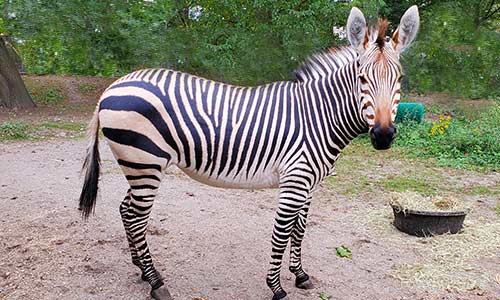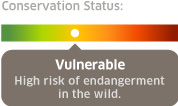Appearance:
Hartmann’s mountain zebras have a “gridiron” of narrow stripes across their back, small dewlap under the chin, and no shadow stripes. They're very good climbers compared to the other species of zebra and they have very hard and pointed hooves. They are in the horse family (Equids) and related to common zebras.
Size:
Adult males weigh on average 656-740 pounds; females weigh on average 608 pounds.
Diet:
These zebras are herbivores and specialized grazers, eating mostly grass. They typically need to consume water one to two times daily.
Reproduction:
Males reach sexually maturity at around 3.5 years of age, but usually do not obtain a herd of their own until around 5 to 6 years of age. Females start to produce young from 3 to 6 years of age, and can stay reproductively active until about age 24. This zebra's breeding season lasts throughout the year, but births peak from November to April. Gestation is about one year (365 days), and one foal will be produced per breeding season. Foals are about 55 pounds at birth and are weaned at 10 months of age.
Social Structure:
A zebra harem is typically made up of an adult stallion, up to three mares and their dependent foals and juvenile offspring. Non-breeding groups mostly consist of just bachelors and sometimes fillies. Unlike the plains zebra, Hartmann's mountain zebras are more likely to remain in smaller groups than to form large aggregations. Herd members usually maintain greater individual distance when grazing, and mutual grooming is less frequent. Both male and female offspring leave the herd at around 2 years of age or shortly after their mother gives birth to another offspring. Mother zebras have been reported to become intolerant of their previous year’s foal and try to drive them away from the herd.
Behavior:
Hartmann's mountain zebras rarely lie down to rest, but will sleep on their feet with their heads hanging low and ears dropped. There is almost always one member of the herd alert who will alarm others if danger approaches. Equids will rub their bodies and heads against trees, rocks and termite mounds, or roll in the dust. Social grooming consists of scraping and nibbling with the incisors and lips typically on the neck, shoulders and back performed simultaneously by two individuals on friendly terms. In most cases mothers and foals, or siblings, are the most frequent participants of this behavior. Zebras will stand in pairs, usually head-to-tail with heads down, where they can swish flies off each other’s faces and are able to see in all directions with their heads up.
Communication:
A barking contact call can occur but rarely, usually by stallions as an alarm signal. A high-pitched squeal, known as a distressed cry, can occur in many instances such as foals rejected by mothers, estrous females during courtship, and bachelor males displaying submission to herd stallions. In addition, they can produce a loud alarm snort and loose-lipped blowing which is the sound of contentment. When greeting new or separated individuals, they will put noses together and sniff followed by rubbing cheeks and continuing sniffing along the body. They will then press and rub their shoulders and sides together or rest their head on the other zebra. This greeting ritual is usually performed by territorial stallions to show dominance, and bachelor males usually for play.
Habitat/Range:
Angola, Namibia, South Africa. Hartmann's mountain zebras primarily occupy the escarpment region of western Namibia that runs north-south along the entire country, between an inland plateau to the east and the coastal desert to the west. Their distribution to this area is due to the fact that they're very water dependent and these mountains provide large numbers of springs throughout the dry season. This zebra's distribution is very affected by rainfall.
Median Life Expectancy:
20 years in the wild
Threats in the Wild:
Hartmann's mountain zebras are strongly affected by droughts, if a further severe drought were to occur this could potentially cause a population reduction of 30% within the next 33 years. Over 3,500 zebras are killed annually under license. Currently this is sustainable but changing climate conditions and over-harvesting could threaten this species.




